-
May 20, 2019 by Total Fire and Safety

(Photo credit: Dreamstime ID 95654936 © Wavebreakmedia Ltd | Dreamstime.com)
With the rise in popularity and construction of senior living centers, fire safety continues to be a concern to keep our grandparents, parents, and aging loved ones protected. According to the United States Fire Administration, in 2015, older adults represented 15 percent of the U.S. population and suffered 40 percent of all fire related deaths. They are also 2.7 times greater risk of dying in a fire than the total population. Those 85 and older were 3.8 times more likely to die in a fire than the total population.
The elderly in multi-level dwellings are at higher risk of dying in a fire for several reasons. They may be on medication that impairs them from taking stairs down to safety, or their mobility issues may prevent them from moving quickly enough. They may live alone or have no one to call for assistance. Educating property managers, caretakers, and the elderly on fire safety for senior citizens is one step we can take in protecting this aging generation. Below are some considerations for property managers and their tenants.
1. Test Smoke Alarms
Smoke is a silent killer. Senior citizens with hearing problems who sleep without a hearing aid could be killed in their sleep. Having a working smoke alarm in every room and hallway helps, but they should be effective for the user. Strobe alarms are best, and seniors can install alarms that shake their bed to rouse them in the event of a fire. Most importantly of all, make sure to test smoke alarms every month so they are always in compliance.
2. Sit Your Butt Down…in the proper place!
Smoking is the number one cause of fire deaths in the country. Remind senior citizens never to smoke in bed and especially not near flammable oxygen tanks. Seniors can use deeper or heavier ashtrays to avoid ashes flipping or falling onto the rug and starting a fire. The best way to put butts out is with sand and water.
3. Create a Fire Escape Plan
Seniors may have less than three minutes to escape danger in the event of a fire. They should have a fire escape plan and practice it, knowing all the accessible exits. For seniors suffering from dementia or Alzheimer’s who have escape proof doors, it is important they have a prearranged escort in the event of a fire.
4. Stay in the Kitchen
Seniors should always stay in the kitchen when cooking. Most kitchen fires begin because food is left unattended, so if they must leave the kitchen while cooking they should turn the burner off. Even a short absence from the kitchen can unexpectedly turn into an extended amount of time away. If seniors must leave the kitchen, they should take a cooking utensil or potholder with them to serve a helpful reminder. Also, remind seniors to never cook with loose or dangling sleeves that can easily ignite and burn a senior, or potentially start a major fire.
5. Daily Necessities
Seniors should think about what they use to get around every day, like glasses, a wheelchair, a cane, etc. These items should be placed next to the bed for easy access in case of fire. A phone and a whistle should also be at bedside. The whistle lets people know where you are and enables you to warn others of the fire. Escape is always the priority; call the fire department later. If trapped, use the phone to call for help. Seniors with wheelchairs or walkers should check exit routes ahead of time to be sure they are accessible or plan an alternate route. Inform building managers or neighbors of the plan. If your impairment makes it impossible to escape in the event of a fire, discuss your concern with landlord, or check with the fire department.
6. Don’t Overload Outlets or Extension Cords
Inspect your extension cords regularly for fraying, exposed wire, or loose plugs. Unplug extension cords when not in use. If you need to plug in multiple appliances, use an extension cord approved by the Underwriter’s Laboratories (UL), a nationally recognized testing laboratory.
As their population begins to grow, fire safety for senior citizens cannot be stressed enough. Property managers, caretakers, the elderly, and their families should all be aware of the increased risk to the age group and try to protect them. The professionals at Total Fire and Safety are ready to help ensure your building has fire equipment that is working properly. We provide the life safety features that keep fire safety for your residents, including senior citizens, a main priority. Give us a call today! 630-960-5060
Category: Fire Alarm Monitoring, Fire exits, Fire Extinguishers, Fire Safety, Total Fire and Safety, Uncategorized Tags: fire and safety solutions, Fire Extinguisher, fire safety, fire safety solution, fire safety training, fire training, first aid, lifesafety, Total Fire and Safety, wireless fire alarm monitoring | Comments Off on Fire Safety for Senior Citizens
-
February 27, 2019 by Total Fire and Safety
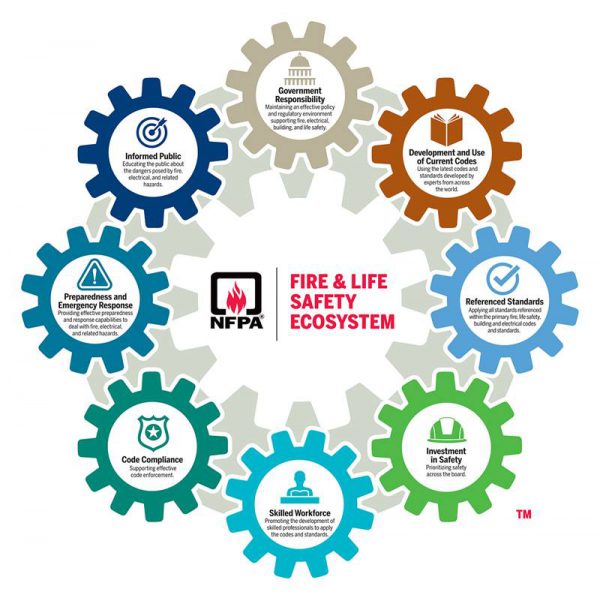 Image: NFPA Website The fire and life safety ecosystem led the discussion at the 2018 NFPA Conference and Expo. What is the fire and life safety ecosystem? Like any ecosystem, it is comprised of elements that work together to achieve a functioning system—in this case, eight separate elements that have to do with fire and safety. Several of them are the responsibility of the government, while many call upon the public to enforce and deliver. Regardless of who is charged with the responsibility, the goal throughout the ecosystem is to prevent major disasters from fire, electrical, and other hazards. When tragedies occur, it is likely there was a breakdown in one or more parts of the fire and life safety ecosystem. Here are the eight components relating to the fire and life safety code:
- Government Responsibility: Policy makers must maintain effective policy and regulatory environment and not prioritize politics over the public’s safety. When life safety codes are stripped for any reason, people’s lives are endangered for the sake of political gain.
- Development and Use of Current Codes: Government and building designers must implement the latest codes and standards or risk losing the latest technology and research in fire, electrical, life safety.
- Referenced Standards: All standards within the fire, life, building, safety, and electrical codes must be addressed or the right products and practices will not be used, possibly leading to disastrous results.
- Investment in Safety: Property managers and need to make an investment in safety to comply with the latest standards and codes. Hiring a company like Total Fire and Safety means an investment in safety. All the latest fire safety technologies are always available from TFS and we can design a program to fit any company’s needs and budget.
- Skilled Workforce: Promote the development of skilled professionals to apply the codes and standards. For over 20 years, TFS has employed highly skilled, highly trained, and highly dedicated workers in order to put customers’ safety above all else.
- Code Compliance: Effective code enforcement is necessary. Fire Marshalls and other officers must conduct regular inspections to ensure safety and code compliance.
- Preparedness and Emergency Response: Provide effective preparedness and emergency response capabilities to deal with fire, electrical, and related hazards. Train employees on emergency equipment, fire safety drills, designated leader in emergencies, etc.. TFS provides training classes for employees, as well as, informative literature on how to react in an emergency and much more.
- Informed Public: Educating the public is important, as is educating businesses about the specific fire hazards in their facilities.
No one cog in the fire and life safety ecosystem can keep us all safe from harm. Even all the pieces together, working in tandem, may not prevent every disaster, but they can certainly prevent many. By practicing and implementing the various areas outlined in the fire and life safety ecosystem, we can all create a safer community. At Total Fire and Safety, we are committed to helping you play your role in the fire and life safety ecosystem. Contact us today to discuss your fire safety needs or call 630-960-5060.
Category: Business Safety, Fire code violation, Fire Safety, Health and Safety, NFPA Compliance, Total Fire and Safety Tags: fire and safety equipment, fire and safety needs, fire and safety solutions, fire safety solution, fire safety training, Total Fire and Safety | Comments Off on What’s a Fire and Life Safety Ecosystem?
-
November 5, 2018 by Total Fire and Safety

Next to the everyday hustle and bustle of the average office, office kitchen fire safety is a secondary concern. However, the National Fire Protection Agency (NFPA) reports that just over one-fifth of office fires begin in the kitchen or cooking area. Twenty-nine percent are started by cooking equipment, the leading cause of fires in the office. Although these fires started small, they caused major structure damage.
With the holidays on the way and more employee parties sure to take place, the office kitchen will be used more than ever. How can you prevent a fire from happening? How do you keep your employees safe and well fed at the same time? Here are four important safety tips to help you get started:
1. Replace worn or frayed power cords.
Inspect power cords on the kitchen appliances. Are the wires exposed? If so, the cord can short out and cause a fire. Encourage your employees to keep an eye out for damaged cords. Be sure to replace them as soon as they are found. This one simple act will keep the office safe.
2. Watch food as it cooks.
It easy to become distracted in the office, whether its fellow coworkers gossiping or doing too many things at once. You wouldn’t leave food unattended at home and the office should not be any different. To ensure food cooks properly, emphasize that employees must stay near appliances as they cook or heat food/beverage. Employees using the kitchen also need to watch for signs of smoke or burning. Doing so will ensure the safety of the entire building.
3. Regularly clean appliances.
We’ve all been there. We stick a (insert food item) in the microwave, oven, toaster, etc., and it explodes or leaves spillage behind. However, we avoid cleaning, commonly thinking someone else will do it. Spills and baked-in foods left behind can cause a fire. Cleaning kitchen equipment after use will prevent grease from accumulating which prevents combustion. These hazards can be avoided easily so remind employees to wipe up spills, food particles left behind, etc.
4. Have employees trained to use a fire extinguisher.
No matter how proactive you and your employees are, accidents still happen. Having staff trained to use fire fighting equipment could mean the difference between a catastrophe or a minor incident. Total Fire and Safety can train you and your employees to use a fire extinguisher, first aid equipment, and other lifesaving safety measures.
With most office fires starting in the kitchen, it is important to educate employees on office kitchen fire safety. Total Fire and Safety (TFS) offers a complete fire training program to educate employees on the proper techniques of fighting a fire. Not only can your employees use these practices in the office, they can also apply them in their home. Keep you, your staff, and your workplace fire safe. Give TFS a call today at 630-960-5060.
Category: Business Safety, Fire Extinguishers, Fire Safety, First Aid, First Aid Kits Tags: commercial fire safety, fire and safety equipment, fire and safety needs, fire and safety solutions, Fire Extinguisher, fire safety, fire safety solution, fireextinguisher, firesafetytraining, first aid | Comments Off on Danger on the Job: Keeping the Office Kitchen Safe
-
March 15, 2018 by Total Fire and Safety
 Nobody thinks much about emergency exit lights. But if the power suddenly goes out, smoke fills the room and you can’t see a foot in front of you, relying on the emergency lights may be your only means of escape. Nobody thinks much about emergency exit lights. But if the power suddenly goes out, smoke fills the room and you can’t see a foot in front of you, relying on the emergency lights may be your only means of escape.
Emergency exit lights are essential to safety in any dangerous situation. They can alarm someone in a fire, be the only source of light in the dark, and the key to safely exiting the building. Emergency exit lights are often overlooked and taken for granted, but take note of how many you come across every day. Do you realize how many requirements and regulations go into the installation and maintenance of one exit sign?
There are numerous agencies that govern emergency exit lighting and signs: OSHA (Occupational Safety and Health Administration), NFPA (National Fire Protection Administration, JCAHO (Joint Commission on Accreditation of Healthcare Organizations and the International Building Code and International Fire Code. Above all these agencies, the local authority is responsible for monitoring and enforcing building/fire codes.
According to OSHA, an exit route is defined as a continuous and unobstructed path of exit travel from any point within a workplace to a place of safety. There are three parts to an exit route:
- Exit access-part of the exit route that leads to an exit.
- Exit-part of the exit route that is separated from other areas and provides a safe means of travel to exit discharge.
- Exit discharge-part of the exit route that leads to directly outside or refuge area.
OSHA’s requirements for the lighting of these afore mentioned exit routes is covered under 1910.37(b). It states that each exit route must be sufficiently lighted so an employee with normal vision can see along the exit route and each exit must be clearly visible and marked by a sign reading “EXIT.” Additional information for OSHA requirements can be found at www.osha.gov.
The NFPA guidance for emergency exit lighting and signs can be found in the NFPA 101, Life Safety Code. The NFPA’s Life Safety Code provides information for placement, illumination, and visibility for exit signs.
- Placement of exit sign. Any exit signs must be located so that no point in an exit access area is more than the sign’s viewing distance, or 100 feet from the nearest sign.
- Visibility of exit signs-Every sign must be located and of such size, distinctive color and design that is visible and contrasts from the background of its placement. NFPA also states no decorations, furnishings, or equipment that impairs visibility of a sign shall be permitted. Nothing should be placed near an exit sign that distracts attention and inhibits visibility of an exit sign.
- Illumination of Exit Signs-The NFPA states all exit signs must be illuminated by a reliable light source and legible in normal and emergency exit lighting modes. There are two categories of illumination: external illumination, which comes from outside the exit sign and internal illumination, which comes from a source inside an exit sign.
According to the NFPA, emergency illumination must be provided for a minimum of 1.5 hours in the event of power outage. The emergency lighting must be illuminated not less than an average of one lumen per square foot. The maximum illumination at any point can be 40 times the minimum illumination. All emergency exit lighting must be able to provide lighting automatically when normal light is interrupted.
Many emergency exit lights are now using LED lights. The NFPA states that LED lights are longer lasting, provide better light and are most durable. In emergency situations, LED lights emit sufficient lighting and are most effective when placed properly. They are also most energy efficient, saving the building money.
According to the NFPA requirements for testing, there are three categories of emergency lights: traditional, self-testing, and computer base self-testing. A monthly activation test which involves having the lights illuminate for no less than 30 seconds and an annual test which keeps the lights illuminated for 1.5 hours, simulating a long-term emergency. Records of these test must be maintained for inspection.
Many regulations, codes, and considerations go into the signs and lights you see every day so it is important to have regular maintenance and testing of these lights. Total Fire and Safety has a knowledge team for inspecting emergency exit lighting. With regular maintenance and testing from Total Fire and Safety, you can be assured your emergency exit lighting is up to code and the safety of your employees/tenants is assured. Give us a call today 630-960-5060.
Category: Business Safety, Fire code violation, Fire Equipment Inspections, Fire exits, Fire News, Fire Safety, Health and Safety, LED Lighting, NFPA Compliance, Total Experience, Total Fire and Safety Tags: commercial fire protection, commercial fire safety, emergency exit lights, emergency lighting, fire and safety equipment, fire and safety needs, fire and safety solutions, fire safety in the news, fire safety solution, fire safety training, lifesafety, safety | Comments Off on Are You In the Dark About Emergency Exit Lights?
-
November 18, 2015 by Total Fire and Safety
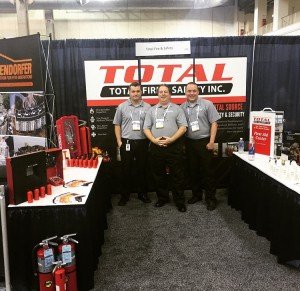 The Total Fire & Safety team is on the scene today at the 2015 Chicagoland Cooperator’s Condo, HOA, Co-Op and Apt. Expo at Navy Pier in Chicago. Pictured here at the TFS booth are (from left to right) Jeff Buff, (Customer Service Representative), Randy Donka (Outside Sales Representative), and Marc Spinder, (Outside Sales Representative). The Total Fire & Safety team is on the scene today at the 2015 Chicagoland Cooperator’s Condo, HOA, Co-Op and Apt. Expo at Navy Pier in Chicago. Pictured here at the TFS booth are (from left to right) Jeff Buff, (Customer Service Representative), Randy Donka (Outside Sales Representative), and Marc Spinder, (Outside Sales Representative).
The show brings together thousands of board and association members, property managers, homeowners and apartment building owners to meet, attend educational seminars and get their questions answered.

For Total Fire & Safety, this is a chance to showcase our various fire safety and first aid solutions. If you’re in the downtown area, join us today at Navy Pier! Free admission and lots of other freebies inside!
If we don’t see you there, contact us any time with your questions regarding fire safety. We’re here to help.
Category: Fire News, Fire Safety, Total Fire and Safety, Trends, Uncategorized Tags: chicago, chicagoland cooperator's condo, fire safety, fire safety solution, first aid, navy pier, news, TFS, today, Total Fire & Safety, Total Fire and Safety | Comments Off on Total Fire & Safety at Navy Pier!
-
March 24, 2015 by Total Fire and Safety
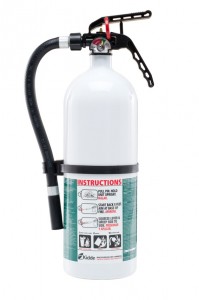 Do you have a Kidde fire extinguisher at home? Do you have a Kidde fire extinguisher at home?
The Kidde plastic valve disposable fire extinguisher has been recalled because of a faulty valve component that can cause failure to fully discharge when the lever is repeatedly pressed and released during a fire emergency. According to Kidde, about 4.6 million units in the U.S. and 175,000 in Canada have been sold with the faulty Zytel® black plastic valves. This affects 31 models of Kidde disposable fire extinguishers.
Kidde has received 11 reports of the recalled fire extinguishers failing to discharge as expected, but no injuries have been reported.
The recalled extinguishers are red, white or silver and are either ABC or BC rated.
The ratings can be found to the right of the nameplate. Manufacture dates included in the recall are July 23, 2013 through October 15, 2014. A 10-digit date code is stamped on the side of the cylinder, near the bottom. Digits five through nine represent the day and year of manufacture in DDDYY format. Date codes for recalled units manufactured in 2013 are XXXX 20413 X through XXXX 36513 X and 2014 are XXXX 00114 X through XXXX 28814 X.
A nameplate affixed to the front of the fire extinguisher has one of the following model numbers: FC10BC, 1A 10BC, 1A 10BCW, 2A10BC, 5BC, 5BCW, FA10G, FA110, FA5B, FC10, FC110, FC5, FH/RESSP, FX10, FX10BC, FX10K, FX210, FX210R, FX210W, FX340GW, FX340SC, FX511, KFH Twin, M110 Twin, M5 Twin, Mariner 10,Mariner 110,Mariner 5,Mariner 5 G,RESSP,XL 5MR, XL 5MR.
The extinguishers were sold at Home Depot, Menards, Walmart and other department, home and hardware stores nationwide, and online from August 2013 through November 2014 for between $18 and $65, and about $200.
Consumers with the recalled fire extinguisher should immediately contact Kidde for a replacement!
Their toll-free line is (855) 283-7991 from 8 a.m. to 5 p.m. ET Monday through Friday, or online at www.kidde.com and click on Safety Notice for more information.
Category: Fire News, Fire Safety, Uncategorized Tags: fire and safety needs, Fire Extinguisher, fire safety recall, fire safety solution, Total Fire & Safety | Comments Off on KIDDE FIRE EXTINGUISHER RECALLED!
-
August 19, 2014 by Total Fire and Safety
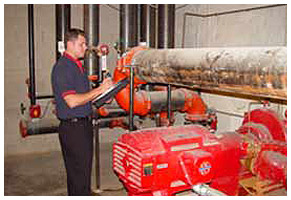 Your commercial fire protection systems should be a “set it and forget it” situation, right? Perhaps, but just like everything, fire systems age too. By updating the system you have, you may be able to save considerable time and money, thanks to advances in the latest life safety technologies. So how do you know when it’s time to update your commercial fire protection? Here are the main telltale signs: Your commercial fire protection systems should be a “set it and forget it” situation, right? Perhaps, but just like everything, fire systems age too. By updating the system you have, you may be able to save considerable time and money, thanks to advances in the latest life safety technologies. So how do you know when it’s time to update your commercial fire protection? Here are the main telltale signs:
Overall age of the system. The industry has made great strides in fire prevention technology in the past decade. The industry continually makes equipment more efficient and reliable, so if it has been a while since you upgraded, chances are you’re missing something.
Changes in your business or areas of your facility. Have you had any changes that would affect the fire code in a particular area of your facility? For example if you have relocated your flammables to a different area of the building, you may need additional protection, such as additional fire extinguishers or alarm monitoring to remain compliant with fire code. A fire protection professional can help you make the necessary adjustments.
Too many service calls. Have you noticed you are calling more often for system malfunctions? Does it seem like you are constantly scheduling a service call from your fire protection service? Are service calls becoming more routine? Are the bills from your fire protection service inflating because of excessive service calls? These are signs that your older system needs an upgrade to function properly. As an added bonus, you will see a reduction in your service calls and maintenance fees!
And the most important reason for upgrading your system…
You are paying too much for your monitoring services. Many companies aren’t aware of how much they are actually paying their service company to monitor their fire safety every month. It’s possible a simple, inexpensive upgrade can result in a remarkable savings over time. For example, many companies are switching to wireless fire alarm monitoring systems, which allows them to cut their dual landlines and save 70% on their alarm monitoring services each month.
If you have an older building, or if you are wondering if an upgrade can save your business money each month, please call Total Fire and Safety at 630-960-5060 for a FREE evaluation of your current commercial fire protection service.
Category: Fire Safety, Uncategorized Tags: commercial fire protection, commercial fire safety, fire and safety equipment, fire and safety needs, fire and safety software, fire and safety solutions, fire safety software, fire safety solution, firesafetytraining, Total Fire & Safety | Comments Off on Four Telltale Signs You Should Update Your Commercial Fire Protection
-
November 4, 2013 by Total Fire and Safety
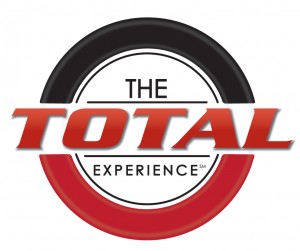 Are you ready for a more convenient, easier way to manage your fire and safety needs? Are you ready for a more convenient, easier way to manage your fire and safety needs?
For more than 20 years, businesses have looked to Total Fire & Safety for comprehensive, fire safety solutions. Recently, however, we began searching to make a good thing even better. We recognize that each day, our customers are challenged with keeping track of the installation, inspection, and maintenance of a growing inventory of fire and safety equipment in multiple locations. We wanted them to be able to see a complete picture of their entire fire and safety needs, all in one convenient record. We also wanted them to have an interface where they could access their own information and conveniently request and track service online. When we couldn’t find anything acceptable on the market, we decided to create something!
With the help of a software developer, Total Fire & Safety developed the Total Experiencesm software for our customers! The Total Experiencesm is a revolutionary, one-of-a-kind, customer interface that provides real-time, comprehensive information about a company’s entire inventory of fire and safety equipment from one convenient, online portal. The fire safety solution is only available from Total Fire and Safety and gives customers convenient access and unprecedented control of their information. Here’s how customers receive the Total Experiencesm !
- Customers login to the Total Experiencesm portal. Data for equipment can be requested by location, address, or managing agent.
- Customers can then drill down to request detailed status information for any piece of equipment. Each record shows date installed, inspected, serviced, and next date of service needed. If a piece of equipment needs service, schedule the appointment online from within the portal and even download the information to an Outlook calendar.
- Next, customers can set and customize “business alerts” by text or email to help remember appointments or times to order service. Business alerts can also give real-time progress updates of service technicians and even estimate their time of arrival on-site.
- Finally, customers can track financial data for each location and piece of equipment, and run valuable reports for making prudent purchasing and maintenance decisions.
Look for the launch of The Total Experiencesm in December! If you’d like to learn more about how the Total Experiencesm can help your business now, contact us at 630.960.5060 or at info@totalfireandsafety.com.
Category: Total Experience Tags: fire and safety equipment, fire and safety needs, fire and safety software, fire and safety solutions, fire safety software, fire safety solution, Total Experience | Comments Off on Coming Soon! The Total Experience: A Revolutionary Fire Safety Solution!
-
February 21, 2012 by admin
Welcome to the Total Fire and Safety Blog. Here you can get more information on keeping yourself, your children and your property safe from fire and disaster with easy preventative steps. Also should an emergency arise, Total Fire and Safety can educate you, your family or your employees on what to do, where to go and how to keep yourself and others safe in an emergency.
There is lots of safety equipment and technology that can prevent disasters as well as minimize the damages. These technologies are all available through Total Fire and Safety:
- Fire Alarms
- Sprinkler Systems
- Fire Pumps
- Backflow Prevention Plumbing
- Fire Extinguishers
- Emergency Lights
- Fire Suppression Systems
- First Aid
Also Total Fire and Safety offers full training courses on all of our technologies and equipment to be utilized properly in an emergency situation.
Category: Total Fire and Safety Tags: commercial fire protection, commercial fire safety, equipment, fire, fire and safety equipment, fire and safety needs, fire and safety solutions, fire safety solution, lifesafety, safety, technology, Total Fire & Safety, training | Comments Off on Total Fire and Safety Blog
|

|
|
|
|
|
|

 Facebook
Facebook
 Instagram
Instagram
 LinkedIn
LinkedIn


 Nobody thinks much about
Nobody thinks much about 




